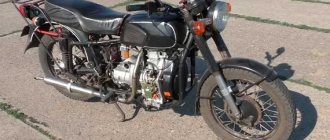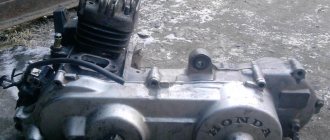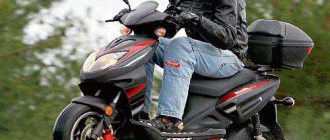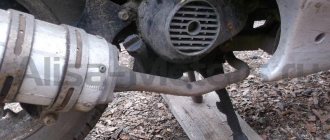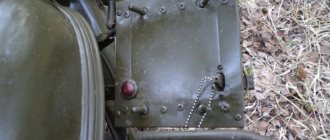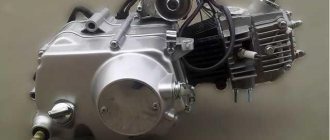Hello, gentlemen! This material is devoted to the repair of the power unit of the K750 heavy motorcycle. Domestic motorcycles of the Soviet period can be seen less and less on the streets of villages and, especially, cities. Seeing a preserved copy in its factory configuration is a great success, since the vast majority are mercilessly altered by the owners to their own taste and requirements.
Each model produced by the Kyiv and Irbit plants had a number of shortcomings and technical flaws. Naturally, all the shortcomings could have been corrected before the assembly line, but, as practice shows, the factory workers put these troubles on the shoulders of the consumer. It is unfair to blame the workers and engineers, since the main stumbling block to the development of the domestic motorcycle industry is the short-sightedness of the management apparatus. And the production and development of motorcycles has never been a priority. Today, Internet resources have fairly high-quality and systematic information about the repair and operation of heavy motorcycles. This shows the potential interest of different age categories in the heritage of our motorcycle industry.
With our opposition bikes there is room for both the technomaniac and the not-so-sophisticated motorcycle owner to have fun. There is always a place where you need to put your hands. Most of the interventions belong to the motor. Almost everything that is possible is improved in them. If we are talking about the chassis, then the path to improvement is quite simple: replacing outdated and bulky parts with higher quality ones from foreign cars. However, there is a separate caste of people called “lovers of antiquity” and the so-called original. When restoring equipment, they dutifully look for standard parts, check serial numbers and follow the recommendations given in the repair tables. Parts damaged by use or time and not subject to further use are replaced with new ones of good quality. Several years ago we were involved in the repair and modification of boxer motorcycles. In 99% these were overhead valve KMZ. The received proposal to repair the engine of a motorcycle that was subject to restoration was received with interest, but before making a decision we took a break to study the mat. parts and complexity of the upcoming process.
Having estimated the time frame for the implementation of the project and the available access to production capacity, we got to work. With a similar design and cylinder layout, the K 750 engine has a number of significant differences that complicate repairs. The difference is the design of the crankshaft (CV), the lubrication system, the pump drive, as well as the arrangement and drive of the valves. The engine arrived by courier service already disassembled. Looking ahead, I will say that another one was purchased to select spare parts. We started with inspecting and cleaning the crankcase. We checked the condition of the landing bearings and went through the threads with taps. After measuring with an indicator-bore gauge, it became clear that there were more than enough problems. The seats for the front camshaft bearing and the front crankshaft bearing races (OPK) turned out to be worn out. The same defects appeared on the unit purchased for disassembly. Later, we measured several more crankcases and we can safely say that the problem of wear and tear on the seat of this race for lower valve engines is widespread. Since the block is numbered and included in the PTS, we decided to restore it. Both holes were milled on a jig boring machine to the required geometry. In the galvanic shop, the outer ring of the OPPC was chrome-plated with further grinding to the size for an interference fit in the crankcase. Having made the necessary trim to seal the inner part of the ball bearing RV, we chromed and ground its outer race. Thus, the front shaft supports have the necessary interference during installation.
The worn bushing of the rear support of the RV was replaced with a new one. The factory one is made of cermet, like the one that is installed on the axis of the oil pump drive gear. Instead, they turned parts from a bronze alloy and drilled holes to supply oil to the rubbing surfaces. Having made sure that everything was in order with the fit of the rear crankshaft bearing housing, we machined the installation space for the felt packing under the double-sided oil seal. Next, the uneven mating planes on the crankcase were removed and the oil lines were sealed. Having previously plugged the oil supply holes at the HF level, both crankcases developed fistulas at the junction with the steel pipes. When the engine warms up, oil loss in these places is more significant. They didn’t even wash the standard oil pump, but simply replaced it with the Ural pump. Both pumps are almost identical and have a difference in performance in favor of the latter. We got it new, but we had questions about it. After checking the gaps in the interface between the drive shaft and the housing and in the gears , decided to install it.
The camshaft was also purchased with minimal wear. A separate chapter is occupied by restoration work on the crank mechanism. Since the CV has a pressed structure, its repair is only possible in production with equipment for heat treatment and grinding. As a rule, the CV and the parts dismantled from it are not enough to reassemble the structure. There are often cases of “garage” repairs, after which damage remains on the front and rear axles. Every second connecting rod was curved from the factory or received deformation during operation, as well as wear on the surface for the rollers. So, from one HF we took the front axle and connecting rods, and on the other - the back. After making new fingers of the lower head of the connecting rod, selecting bearings, straightening the connecting rods with replacing and reaming the bushings, we assembled it. We measured the runout on the main journals and adjusted it to acceptable values. As in the case of MT engines, the problem is the selection of timing gears. They have values of axial and radial runout that are greater than permissible, and the crankcases have different center-to-center shaft alignments. The shortage and noise of the drive prompted the owners of Soviet motorcycles to look for an alternative. This is either making a new pair to order , or purchasing a combined gear - steel/caprolon. In our case, the first option was not found, and the second did not suit the customer, since there are negative operational reviews about such products. We continued the search and settled on a pair with a gap acceptable for installation on the engine. The flywheel was “skinned” on a lathe, minimizing the axial and radial runout. The surface on which the oil seal will work was ground. We manufactured and replaced the pins for the clutch discs, having previously threaded them with m8*1.25 to use high-quality hardware with an internal hexagon, which is much more convenient than screws for a screwdriver. New clutch discs and springs were purchased. The gas distribution mechanism in the front crankcase cover was repaired. The breather seat was milled and the rotating part was chrome plated and ground to size.
A standard steel pan was used on the engine. Before installation, a magnet was installed in it to collect friction products. At the beginning of the repair of the CPG, it was cleaned and disassembled with troubleshooting. Having assessed the condition of the parts, we found out that one cylinder had a factory defect - the guide had a through hole to the outside. How such a part was allowed onto the assembly line remains a question. We used the required cylinder from a purchased donor engine. Boring was done for pistons from the local manufacturer TRT, size 79.0. They have three grooves for rings, and their skirts are coated with a molybdenum compound. Piston rings were used from the manufacturer Prima. Next, plates were made from sheet aluminum to protect the contact surfaces of the cylinders and heads from the effects of sandblasting. After cleaning and forming working chamfers on the valve seats, they were ground in and checked for leaks. Having degreased the surfaces, the cylinders were painted with heat-resistant paint, and the valve boxes were sealed with paronite washers on oil resistant sealant. Before final assembly, damaged studs and all external fasteners were replaced. The engine used Koyo bearings, Corteco oil seals, and Reinz engine sealant.
K-750
The heavy motorcycle K-750 appeared as a result of the modernization of the famous motorcycle from the Great Patriotic War M-72.
Initially, the M-72 was planned to be produced at factories in Moscow, Leningrad and Kharkov. Probably, the letter M just meant the Moscow Bicycle Plant, located in the Kozhukhovo district in the southern part of the capital. When the war began, the factories had to be evacuated. Moscow - to the Ural Irbit, Leningrad and Kharkov - to Gorky. As a result, the Gorky Motorcycle Plant arose on the territory. He successfully produced the M-72 at the end of the war and the first years after the Victory. But in 1949, the government decided to repurpose the Gorky Motorcycle Plant and transfer the production of the M-72s needed by the country to Kyiv.
Since 1945, a motorcycle factory operated on Kagatnaya Street in the capital of Ukraine. He produced a light motorcycle K-1B “Kievlyanin” of the 125 m3 class, a clone of the German Wanderer. They decided to sacrifice this model for the sake of the former Gorky M-72. However, the restructuring of production took several years. The first heavy motorcycles rolled off the Kyiv assembly line in 1951, but they were assembled from imported parts. First from the Gorky stock, and when it ran out - from the Irbit stock, and in parallel with the assembly of the last batches of the “Kiev” ones. By 1955, it was possible to master the full production cycle, but the M-72, created before the war, was completely outdated by that time.
The result of the gradual modernization of the motorcycle was the new model K-750 of 1958, an original Kiev development, which was not a copy of the Ur Al motorcycles obtained through a separate modernization of the M-72, carried out in Irbit. As a result, the country has two independent manufacturers of heavy motorcycles of the same class. To reduce competition, planning authorities tried to distribute and sell Kyiv motorcycles in the European part of the country, and Irbit motorcycles beyond the Urals.
The K-750 engine was equipped with new cylinder heads: the shape of the ribs changed and the compression ratio increased. The front engine cover with breather became different. Two oil scraper rings appeared on the piston, and ribs were made on the oil sump for better cooling. The rear wheel suspension became pendulum, spring, with telescopic hydraulic shock absorbers, which were absent on the M-72 and its modifications. Finally, the K-750 differed from its predecessor in a new stroller with a spring (not torsion bar) wheel suspension and a hydraulic shock absorber.
In 1963, the modernized K-750M appeared. An automatic ignition advance and a paper element in the air filter were installed on some cars. Instead of an M-72 type gearbox, a modernized one was installed, and the front fork also changed: it featured double-action hydraulic shock absorbers and increased wheel travel.
K-750 motorcycles were widely used by the police. The 50-60s were a time of massive use of motorcycles with sidecars as patrol vehicles. The police K-750 starred in Eldar Ryazanov’s famous film “Beware of the Car.” In it, the traffic police inspector, played by Georgy Zhzhenov, pursues Yuri Detochkin’s Volga, and before that he starts the motorcycle itself from a tow using the same Volga: “With an old battery, this is not life.”
K-750 motorcycles were found among private owners back in the 60s, but many of them were decommissioned from the army and police and “privatized” in the 70s. Currently it occurs quite often. The Museum displays a restored K-750.
Technical specifications
| Number of places | 2-3 |
| dimensions | 2400x1600x1060 mm (with side trailer) |
| Width and track with sidecar | 1700x1110 mm |
| Wheelbase | 1450 mm |
| Engine | gasoline, carburetor, two-cylinder, four-stroke, opposed, lower valve |
| Working volume | 746 m3 |
| Power | 26 at 2900 rpm |
| Dry weight | 315 kg |
| Maximum speed | 95 km/h |
| Average fuel consumption | 7 l/100km |
